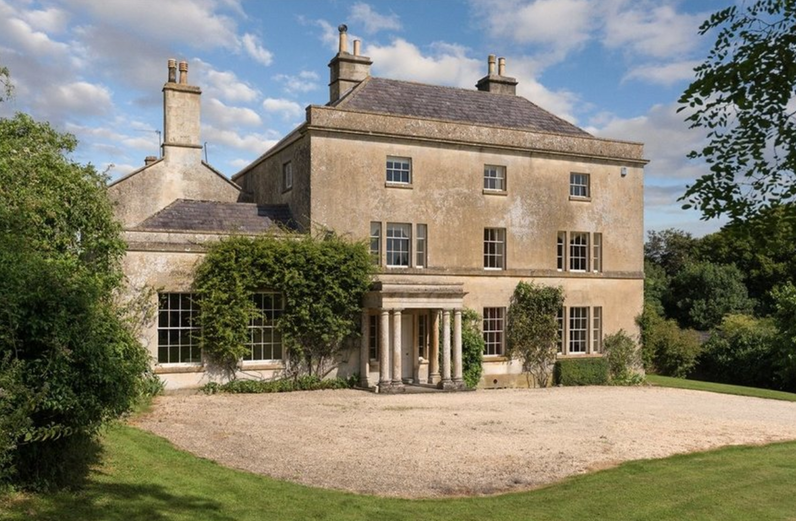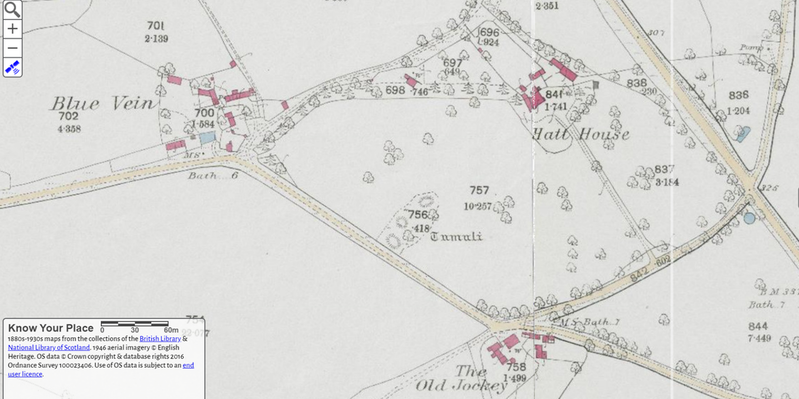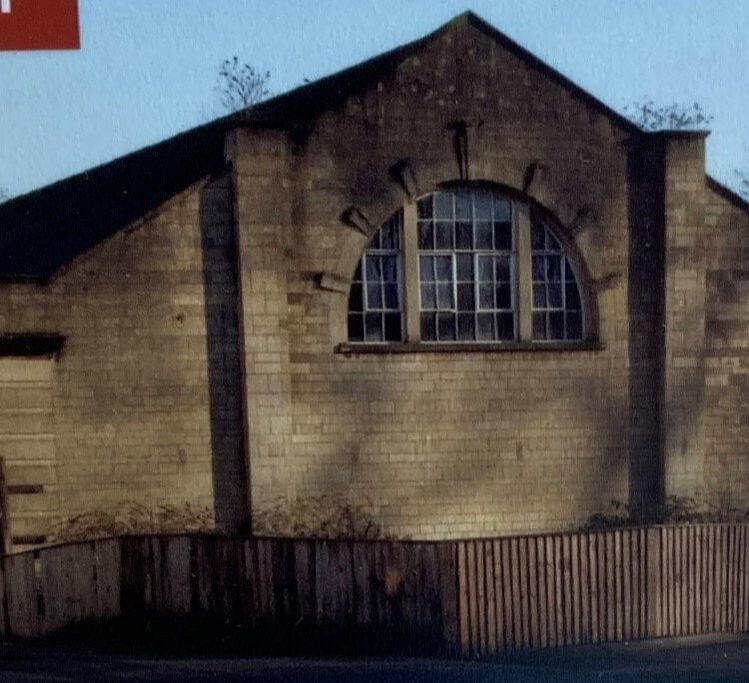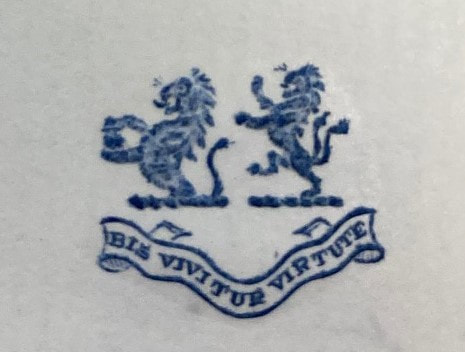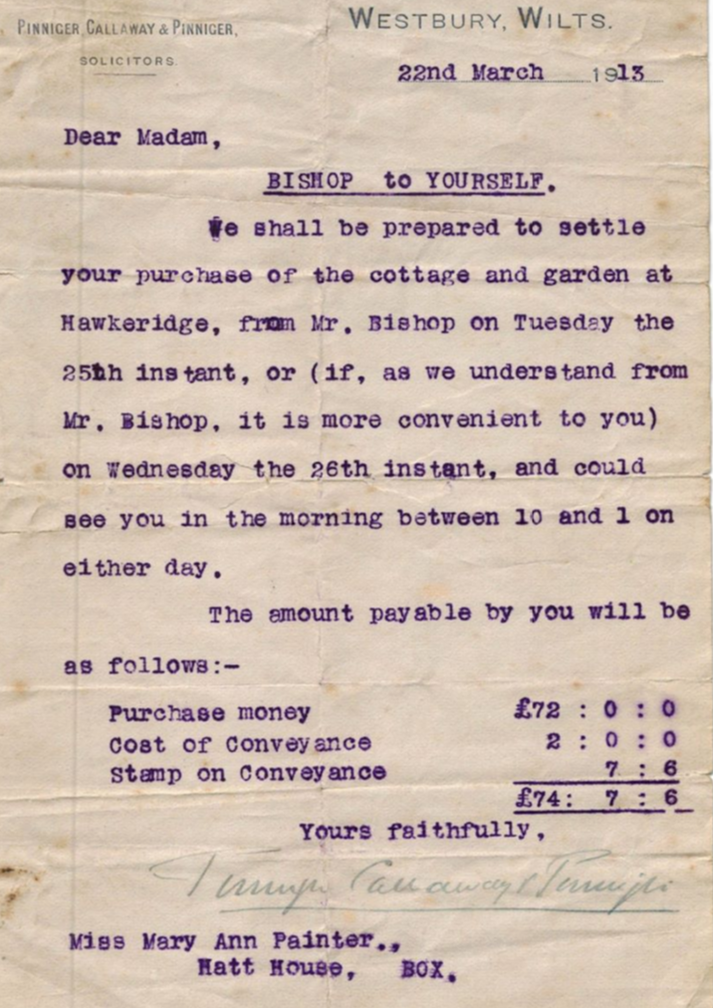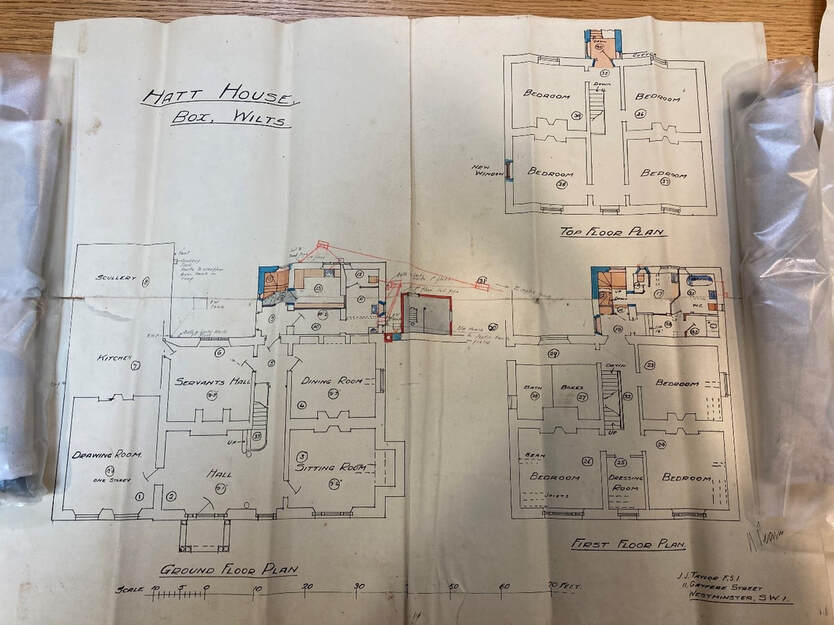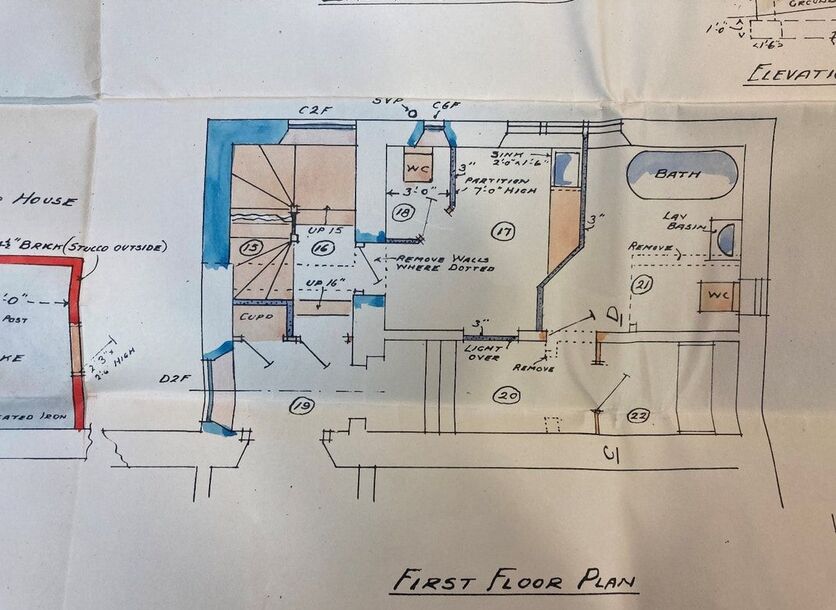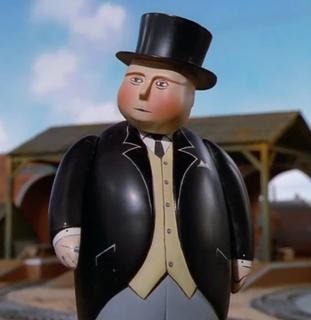Hatt House Researched, written and photos Claire Dimond-Mills September 2020
Hatt House is not a property that many people know about. Hidden in woods on the outskirts of Box, in the hamlet of Old Jockey, Hatt House was until very recently owned by the explorer David Hempleman-Adams. But what else do we know about the house and did any other famous people live there?
The Early Area
The current house is dated 1820 and is late Georgian in style but we know people have been living in the area of Hatt since at least the thirteenth century when Reginald de Hatt lived in this minor manor, and later in 1485 Robert de Hatte and John atte Hatt.[1] This is almost certainly where the name comes from. Later owners were a William Kenyon in 1634 and then George Speke who died in 1652.[2] Several articles have been written about the Speke family. They were the major landowning family at the time and lived at Hazelbury manor. It is unlikely they lived at Hatt House but rented it out.
Lionel Duckett is said to have owned a property in the area in 1682 but his will, which is difficult to read, dated 1693, refers to Hatt Farm and all cottages, lands, pastures, woods surrounding it, not Hatt House. There is also a document in the National Archives in Kew about a property disagreement in Box dated 1693 between Lionel Duckett and George Speke Petty. Did Lionel’s death bring some of the property ownership into doubt?
The Early Area
The current house is dated 1820 and is late Georgian in style but we know people have been living in the area of Hatt since at least the thirteenth century when Reginald de Hatt lived in this minor manor, and later in 1485 Robert de Hatte and John atte Hatt.[1] This is almost certainly where the name comes from. Later owners were a William Kenyon in 1634 and then George Speke who died in 1652.[2] Several articles have been written about the Speke family. They were the major landowning family at the time and lived at Hazelbury manor. It is unlikely they lived at Hatt House but rented it out.
Lionel Duckett is said to have owned a property in the area in 1682 but his will, which is difficult to read, dated 1693, refers to Hatt Farm and all cottages, lands, pastures, woods surrounding it, not Hatt House. There is also a document in the National Archives in Kew about a property disagreement in Box dated 1693 between Lionel Duckett and George Speke Petty. Did Lionel’s death bring some of the property ownership into doubt?
Another search in the National Archives for Hatt House brought up a document pertaining to the lease of land by Richard Long of Hatt House, Box, in 1695, although the original Hatt House may not have been on the current footprint. There seem to be no surviving pictures or plans of the original house so it is difficult to ascertain how grand the original house was. There is then a big gap between Richard Long and the building of the new house in the 1820s and the parish records for the period 1550-1830 show no mention of Hatt House.
The first mention of Hatt House in the parish records is of the death of Mary Pinchin, wife of George Pinchin of Hatt House in 1834. Mary and George’s two daughters were baptised in Box: Mary in 1824 and Georgina in 1826, which provides strong evidence that it was George Pinchin who built the current house in the 1820s.
The map shows the Hatt House site on the Box Tithe Map of 1840. The original house had been accessed from the Drilley track coming from the toll house at Blue Vein. The current drive must have been built at the same time as the new House.
The first mention of Hatt House in the parish records is of the death of Mary Pinchin, wife of George Pinchin of Hatt House in 1834. Mary and George’s two daughters were baptised in Box: Mary in 1824 and Georgina in 1826, which provides strong evidence that it was George Pinchin who built the current house in the 1820s.
The map shows the Hatt House site on the Box Tithe Map of 1840. The original house had been accessed from the Drilley track coming from the toll house at Blue Vein. The current drive must have been built at the same time as the new House.
George Pinchin
George Pinchin, brewer and part owner of Northgate Brewery, Bath, lived at Hatt House on the 1841 and 1851 census.[3] At one time the brewery was owned by him and a partner, George Simms of Montebello House, Bathwick Hill, and was reputed to be the largest brewer of its kind in the South West. Later the company was called Messrs George Pinchin & Co of Bath. It was a long-established business, and George appears to have bought into it sometime after 1809 but before 1821.
George Pinchin, brewer and part owner of Northgate Brewery, Bath, lived at Hatt House on the 1841 and 1851 census.[3] At one time the brewery was owned by him and a partner, George Simms of Montebello House, Bathwick Hill, and was reputed to be the largest brewer of its kind in the South West. Later the company was called Messrs George Pinchin & Co of Bath. It was a long-established business, and George appears to have bought into it sometime after 1809 but before 1821.
George lived with his second wife, Margaret Lewis, and two daughters, Mary and Georgina, in some style at Hatt House. Unlike many manufacturing businesses, brewing was a respectable commercial activity for the landed class. They were important local people and very wealthy, employing a butler, cook, ladies’ maid, two servants and a coachman, who lived with his own family in Hatt Cottage. George didn't own the freehold of the house in 1826, which he rented from John Fuller. Nearby Hatt Farm was also owned by John Fuller and let out to David Rice Pinchin; probably George's brother.
A stained-glass window was erected in the south aisle of Box Church: To the glory of God. In Memory of Mary the wife of George Pinchin of Hatt House in this parish and five of their children, 1857. In 1858 George, Margaret and family moved to Bathwick Hill House, Bath, where he died on the 6 February 1861. George's estate at the time of his death was significant at about £4,000 (worth perhaps £400,000 in today's terms) and he made provision for Margaret, who continued to live for a further twenty years in some style on income derived from dividends.
A stained-glass window was erected in the south aisle of Box Church: To the glory of God. In Memory of Mary the wife of George Pinchin of Hatt House in this parish and five of their children, 1857. In 1858 George, Margaret and family moved to Bathwick Hill House, Bath, where he died on the 6 February 1861. George's estate at the time of his death was significant at about £4,000 (worth perhaps £400,000 in today's terms) and he made provision for Margaret, who continued to live for a further twenty years in some style on income derived from dividends.
Captain James W Balfour
Retired Captain of the 7th Dragoon Guards, his wife Isabella and their sons William and James moved to Hatt House in 1858 shortly before the birth of their third son, John. Two daughters Isabella and Mary were born shortly after and then Maria in 1866. Like the Pinchins, the Balfours had a host of servants, including a governess and two nurses to look after the children, a cook, a housemaid, a groom and a page. In addition, there would have been gardeners who lived elsewhere in the area of Old Jockey,
Blue Vein and Hatt.
Sadly, life at Hatt House was struck with tragedy with the death in 1862 of James Stanley Balfour (aged 6) and again in 1871 when Isabella died, aged 13. We do not know why the children died but it is likely they died from childhood diseases common at the time such as measles, scarlet fever or consumption (tuberculosis).
Retired Captain of the 7th Dragoon Guards, his wife Isabella and their sons William and James moved to Hatt House in 1858 shortly before the birth of their third son, John. Two daughters Isabella and Mary were born shortly after and then Maria in 1866. Like the Pinchins, the Balfours had a host of servants, including a governess and two nurses to look after the children, a cook, a housemaid, a groom and a page. In addition, there would have been gardeners who lived elsewhere in the area of Old Jockey,
Blue Vein and Hatt.
Sadly, life at Hatt House was struck with tragedy with the death in 1862 of James Stanley Balfour (aged 6) and again in 1871 when Isabella died, aged 13. We do not know why the children died but it is likely they died from childhood diseases common at the time such as measles, scarlet fever or consumption (tuberculosis).
|
I have only been able to find brief details of Balfour’s military career before moving to Box. On the 1861 census he was adjutant to the North Somerset Yeomanry, a volunteer regiment of cavalry, originally set up to defend Britain should Napoleon and France try to invade in the late 1790s. They also maintained order, as there were no organised police forces, as well as supplying volunteers should war breakout.
The North Somerset Yeomanry was based north of the Lower Hayesfield School, Bath. Now dominated by a hotel, the area was previously the drill ground with an impressive gateway and guard house facing the Lower Bristol road, of which all that remains is the drill hall. An adjutant is an officer who supports the Commanding Officer with administrative tasks. By 1881 James Balfour had returned to Balfour Castle, the family seat on the Island of Orkney in Scotland. |
William Eaton-Young
By 1878, William Eaton-Young had moved to Hatt House with his wife Mary, born in Malta, and their children Cecil and Hugh, aged 5, and Felix, aged 3 who was born in Box. Born in Bombay, India, to William Jackson Eaton, gentleman, William studied at Queen’s College, Oxford and then law at Inner Temple becoming a barrister. But the 1881 census said that 33-year-old William was no longer a practicing as a barrister and instead had turned to politics.
In 1880, William was the Honourable Secretary of the North Wiltshire Liberal Club and had encouraged the gentlemen of Box to start the Box club with himself as chairman. The Liberal Club was not the only club William instigated as he was also a founding member of Kingsdown Golf Club.
The Eaton-Youngs followed similar tragedy to the Balfours with the death of their infant son Felix in May 1881 which may be why they had left Hatt House by 1882 to be replaced by the Story-Maskelyne family.
By 1878, William Eaton-Young had moved to Hatt House with his wife Mary, born in Malta, and their children Cecil and Hugh, aged 5, and Felix, aged 3 who was born in Box. Born in Bombay, India, to William Jackson Eaton, gentleman, William studied at Queen’s College, Oxford and then law at Inner Temple becoming a barrister. But the 1881 census said that 33-year-old William was no longer a practicing as a barrister and instead had turned to politics.
In 1880, William was the Honourable Secretary of the North Wiltshire Liberal Club and had encouraged the gentlemen of Box to start the Box club with himself as chairman. The Liberal Club was not the only club William instigated as he was also a founding member of Kingsdown Golf Club.
The Eaton-Youngs followed similar tragedy to the Balfours with the death of their infant son Felix in May 1881 which may be why they had left Hatt House by 1882 to be replaced by the Story-Maskelyne family.
|
The Story-Maskelyne Family
We know that Edmund Story-Maskelyne was living at Hatt House in 1882 as he appeared in a newspaper report about the Corsham Branch of the Wiltshire Friendly Society, of which he was chairman. The census records 1891 to 1911 give us a few more details about the family in the house. Like his predecessor, Edmund was a retired barrister. His daughter, Inez Agnes Mary, was born in London which is where he undoubtedly worked as a barrister but returned to the county of his birth (Lydiard Tregoze, Swindon) when he retired. Edmund was the younger son of Anthony Mervin Storey and Margaret Maskelyne who had an estate at Wroughton, Wiltshire. The Story-Maskelyne family crest is a rampant lion holding a shell. |
|
Edmund was rather overshadowed by his older brother Nevil, who was a geologist and pioneer of photography, being a close friend of Henry Fox Talbot, who lived at nearby Lacock Abbey. The above coat of arms came from a letter written by Nevil’s wife Thereza, an astronomer and pioneering photographer herself. Nevil Story-Maskelyne’s prints are very sought after, a recent one selling for $25,000. In the 1911 census Edmund, Martha and their daughter Agnes had three servants. Mary Ann Painter, 28, domestic cook; Florence Thorn, 24, parlour maid and Ethel Painter, 23, Mary’s sister, housemaid. This seems quite a small staff for such a large house but maybe now in their 80s Edmund and Martha weren’t entertaining as much or using as much of the house. They appear to have paid their staff well, as Mary Ann had enough money to buy a house in 1913. The letter shows it cost Mary Ann £74 to buy a cottage in Hawkeridge (near Westbury where she was born). In today’s money that is about £4,400. Edmund died on 29 August 1915 and his probate listing states he was still living at Hatt House. His wife Martha died in 1920 and his daughter Inez Agnes in 1958. Agnes’ probate listing states she was living at The Hermitage, Box. It is likely the women moved there after Edmund died as we know Miss Doris Chappell was living at Hatt House in the 1920s. |
Miss Doris Chappell
Doris Chappell and her mother Jessie bought Hatt House in the 1920s and they shared the house until Jessie's death in 1930. In the 1939 Register, Miss Chappell’s occupation was given as Hospital Chairman living on private means.
Miss Chappell lived in the house until 1978, over half a century, and made several improvements as shown by these plans at the Wiltshire and Swindon History Centre. The house plan looks a bit like a Cluedo board! But if you compare it to a picture of the house, it shows the drawing room (single storey) and kitchen behind must have been added on after the main house was built and the porch probably added to make the house look more symmetrical. And then a two-story wing was added to the back at some point. This housed a back kitchen with sinks downstairs and a large bathroom upstairs. Indoor bathrooms became fashionable and more common for the upper classes at the turn of the 20th century and so it is likely that is why and when this section was added. The second plan shows Miss Chappell wanted to rearrange some walls and an accompanying letter suggests there was a problem with the drainage.
Doris Chappell and her mother Jessie bought Hatt House in the 1920s and they shared the house until Jessie's death in 1930. In the 1939 Register, Miss Chappell’s occupation was given as Hospital Chairman living on private means.
Miss Chappell lived in the house until 1978, over half a century, and made several improvements as shown by these plans at the Wiltshire and Swindon History Centre. The house plan looks a bit like a Cluedo board! But if you compare it to a picture of the house, it shows the drawing room (single storey) and kitchen behind must have been added on after the main house was built and the porch probably added to make the house look more symmetrical. And then a two-story wing was added to the back at some point. This housed a back kitchen with sinks downstairs and a large bathroom upstairs. Indoor bathrooms became fashionable and more common for the upper classes at the turn of the 20th century and so it is likely that is why and when this section was added. The second plan shows Miss Chappell wanted to rearrange some walls and an accompanying letter suggests there was a problem with the drainage.
Miss Chappell died on 29 December 1978, aged 90, and the property was left to Andrew Boyle, her nephew from her sister's family, who later sold the property to David Hempleman-Adams.
|
As an Aside
Did you know that the name of the Fat Controller in Thomas the Tank Engine is Sir Topham Hatt? Rev Awdry who wrote the Thomas books lived at Lorne House when he was a child and many aspects of his books are based on elements of Box history and landscape. Is this another one? Certainly the unusual spelling of the surname indicates so. Some real characters have lived at Hatt House who have had a great impact on Box from a famous explorer and indominable spinster to a founder of Kingsdown Golf Course and the Pinchins, one of Box’s great Victorian families. Who will live there in the future and how will they shape our wonderful village? |
References
[1] Katherine Harris in her excellent book Up Hill and Down Hill: My Childhood in a Village Hamlet
[2] Pevsner’s Architectural History of Wiltshire
[3] See article about Pinchin's Box Brewery
[1] Katherine Harris in her excellent book Up Hill and Down Hill: My Childhood in a Village Hamlet
[2] Pevsner’s Architectural History of Wiltshire
[3] See article about Pinchin's Box Brewery
